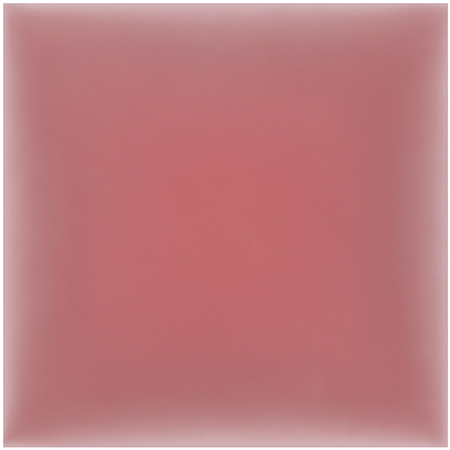
Continuing through March 2, 2024
The three largest paintings in Gwen Hardie’s current exhibition are 60 by 60 inches square, while the remaining 19 are smaller, in many cases much smaller. All are untitled except for an indication of their main colors, and almost all painted in 2023. All are executed on square canvas formats so as not to allude to the idea of vertical portraiture or horizontal landscapes. Many of the paintings are too large to be considered small, while the majority are not large enough to evoke the abstract-sublime aesthetics of color field painting.
We could be forgiven for seeing these canvases as monochromes, but they are, in fact, something more subtle and far more intricate. They are richly saturated polychromes executed in multiple layers of diluted oil paint, optical mixtures that coalesce into what appears to be a singular color. This effect mirrors how a multiplicity of musical notes can harmonize into a single chord. This is accomplished with a modified glaze technique that harks back to the fifteenth century, a technique that has fallen out of favor during the past two centuries. It facilitates subtle refractions of light, lending the paintings an inner luminosity.
Despite their apparent simplicity, Hardie’s surfaces achieve remarkable depth and resonance, with only the faintest sign of distinct brushstrokes. The artist applies the colors with a fan spreader brush that she changes up between wet-into-wet and wet-into-dry applications. Also visible are shifts in the amount of linseed oil that Hardie uses in her paint medium, allowing her to modulate with precision the reflectivity of her surfaces.
The exhibition divides into three color schemes that are revisited in multiple variations. The major portion manifests in tight spectra of yellow-orange, pink and the occasional understated green, tipping their hats to the spectral atmospherics of J.M.W. Turner’s famous seascapes. A few works are delicately executed explorations of off-white pearlescence, resembling translucent porcelain lit from behind. Another subgroup presents variations on red wine, looking at once like forthright surfaces and deep pools of undifferentiated nocturnal space. If they were similar in scale, they would compare favorably to Mark Rothko’s late paintings ensconced at Houston’s Rothko Chapel. Hardie’s paintings balance their mysteries with a beguiling preciousness that makes them seem much larger than they are.
One way of approaching these works is to see them as studies in complexion that exaggerate their nuance. Figure painters are always challenged by the need to capture realistic skin tones in highlights, mid-tones and shadows. Some, like Titian, make that complexity a hallmark of their work. It is easy to imagine that Hardie started as a figure painter and developed the work for this exhibition in the course of addressing those challenges.
In the 1990s, Byron Kim produced paintings that were based on the skin colors that comprised the options featured in an upscale cosmetics display, reducing skin color to a system of Pantone variations. By contrast, Hardie’s paintings eschew oversimplification by registering subtleties of complexion. They remind us that the surfaces of paintings can be likened to skin — not only in its role as protective membrane that contains the body as a vessel contains liquid, but also as a breathing sieve that filters inflows of nourishment and trauma while also expelling toxins. If surface is the great revealer, as Oscar Wilde once wrote, then the radiant complexity of Hardie’s surfaces reveals all in ways that are excruciatingly intimate and worldly.
